Meme-The 6 Core Design Elements Of CP Manager
Click on image to see full size.
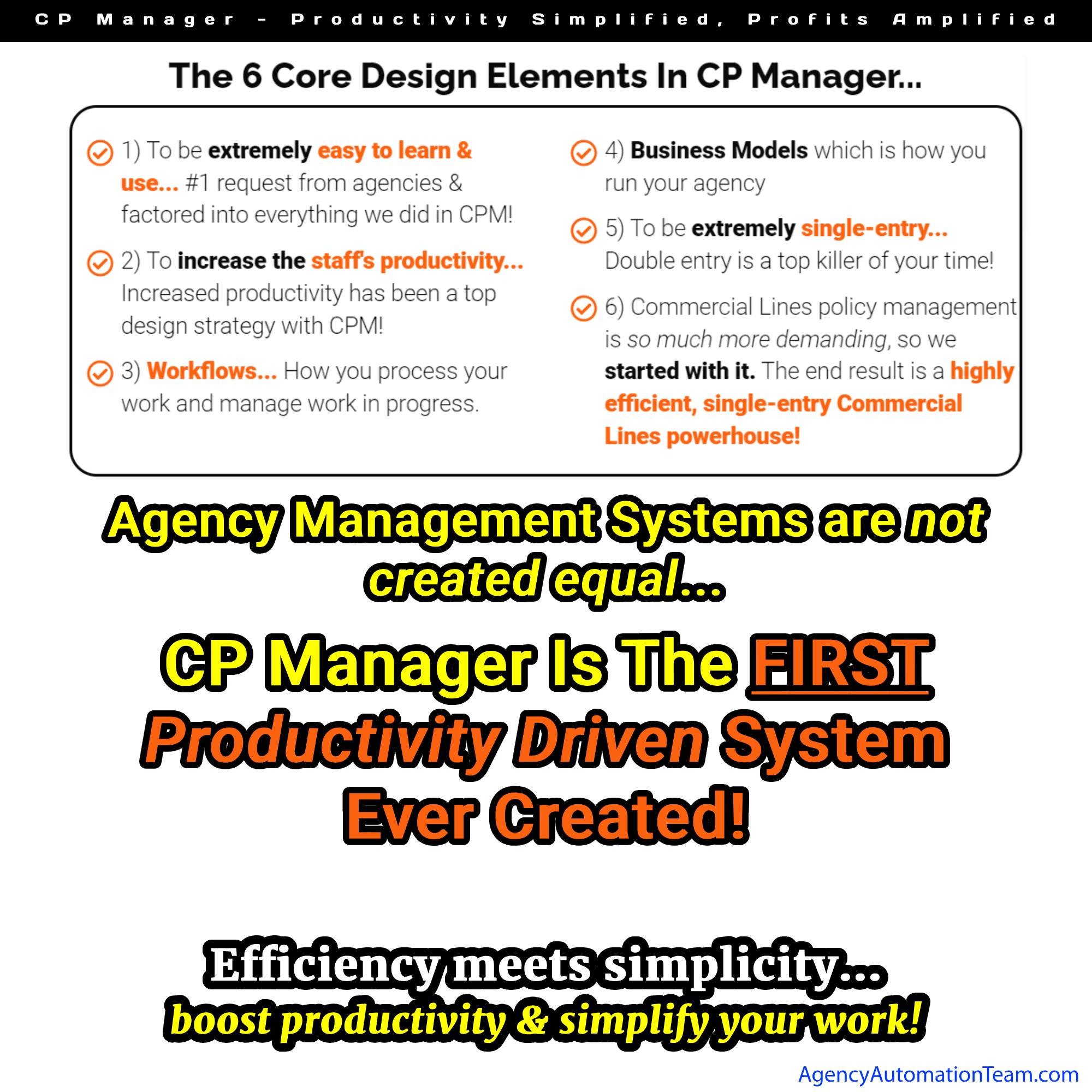
Click on image to see full size.

It's been a while since we've written an article. We've all been super busy building one hell of an agency management system!
Since our last "Upgrades" article in 2022, we've added over 300 features to CP Manager, to include a few big upgrades.
One of the problems with having an insurance automation consultant as the designer of the system and President of the company, he's really obsessed with having a killer system. It's the constant tweaking & improving of the system which has everyone amazed at some of the incredible things Mr. Chesnut comes up with to improve CP Manager!
In the beginning of CP Manager, Mr. Chesnut's objective was to create a highly productive system which would allow agency staff to get their work done in far less time. Along with this was to create an extremely easy and intuitive system to learn and use.
Plus, from watching how the industry has evolved and changed, it was creating a management system which would support just about any type of business model an agency would choose to put in place, whether everyone worked out of an office or CSR's worked from home, to name just two business models.
Along with this was giving the producers the ability to do their work from anywhere! Whether it's meeting a prospect/client at a coffee shop or at their home/business they can process their work from their smart phone or tablet giving them far more flexibility in doing their job.
When designing CP Manager, it was designed to support the large agency doing thousands of entries a day. To support this design strategy, we have implemented very powerful "find" features so you can find that needle in a haystack whether it's a specific note you're trying to find or an attachment or anything else.
CP Manager has an agency with over 80 users and with multiple agencies under it. Yes, CP Manager also has a very powerful multi-agency management ability.
This agency has big needs because of the massive amount of business they write and support. This gave Mr. Chesnut the ability to see where he could enhance, tweak and improve CP Manager for a large agency.
When it came to entering clients, policies, notes, follow-ups, and attachments (the foundation of a system), CP Manager was far better than the large agency hoped, far exceeding their expectations. Super easy, very single-entry, fast & easy to access the information, and shockingly fast to input the information!
When it came to the daily functions of the agency, CP Manager was, in their words, "mind-blowingly easy and efficient."
The two areas we made some huge improvements in to support this large agency were in the multi-agency management functionality and adding some additional accounting functionality.
For the accounting improvements we made, it was all focused around "time is money". This large agency received direct bill commission statements 6, 8 even 10 pages long! Saving a step here and another step there added up to a lot of time.
We already had "Direct Bill Reconciliation" in CP Manager, which also has a "Save & Finish Later" function allowing them to process their commission statements over a period of time. But, having to add a new B-Tran (Billing Transaction) because it didn't get added or needing to edit a B-Tran required a few additional steps we knew we could cut with a redesign on how an agency would reconcile their commission statements.
Introducing the DB Commission Management feature...
With this new feature we streamlined the DB commission management process dropping the time taking to handle this process by a good 40% with many page commission statements. It's one window where you can do everything needed to reconcile and process your DB commission statements. (Click on images to see it bigger).
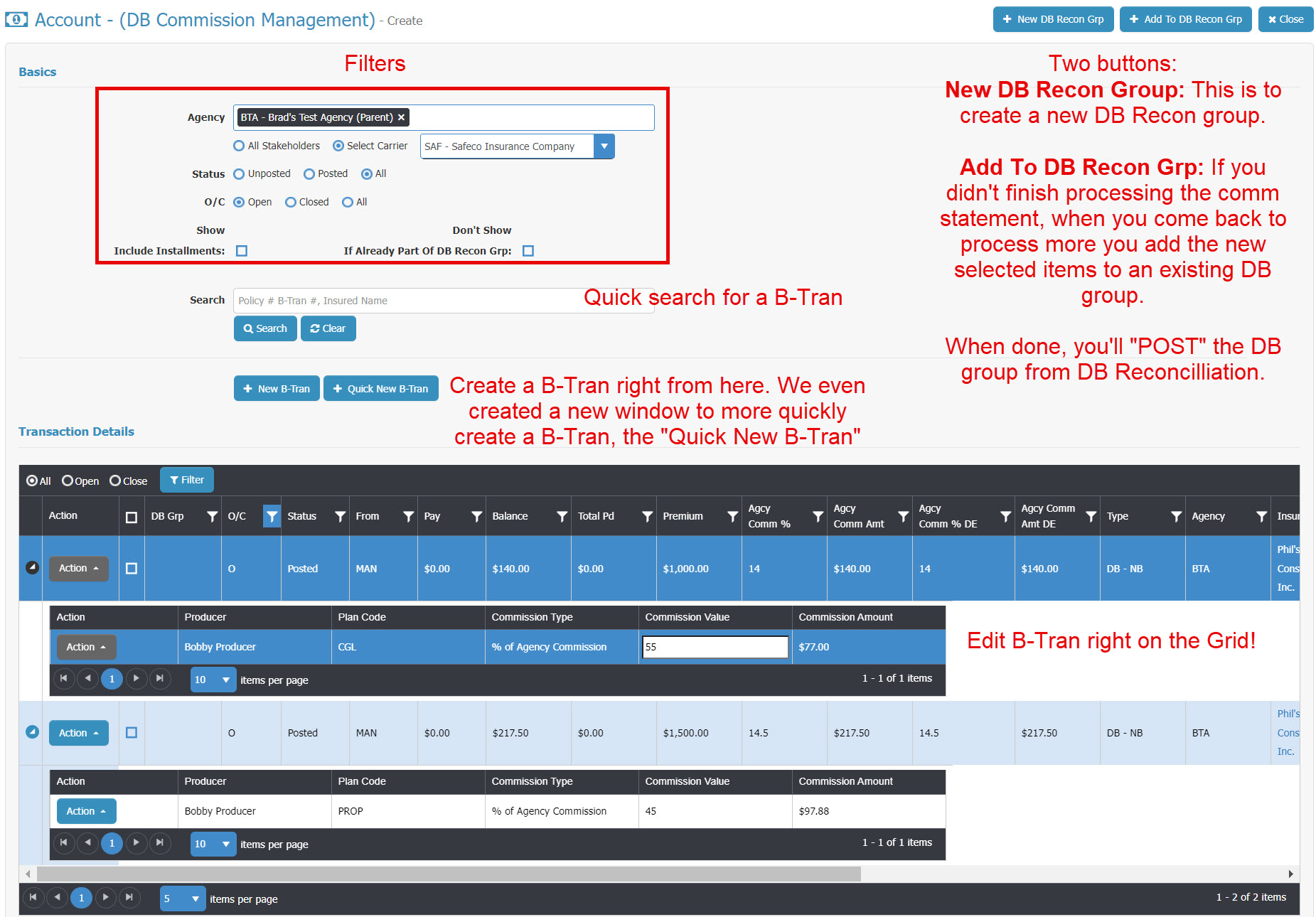
This is simply a remarkable new feature.
To enhance this new feature we created a faster way to create B-Trans on the fly...
When you click the button a window pops up to choose the Client & Policy the B-Tran is being attached to. You can either first select the client and then select from that clients policies, or you can just enter the policy number which auto-selects the client...
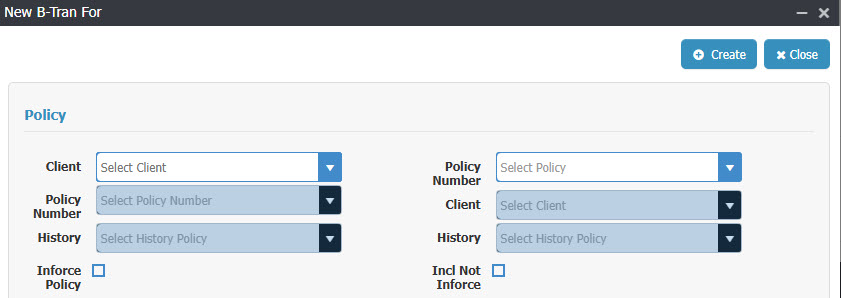
If you have the policy number, it's just one step to start the process of creating the new Quick B-Tran.
We also give you the ability to select a history policy which is important for audits and doing a B-Tran for the previous policy term. The B-Tran is tied to the policy term.
You're then taken to the Quick B-Tran Window... (2 images to show)
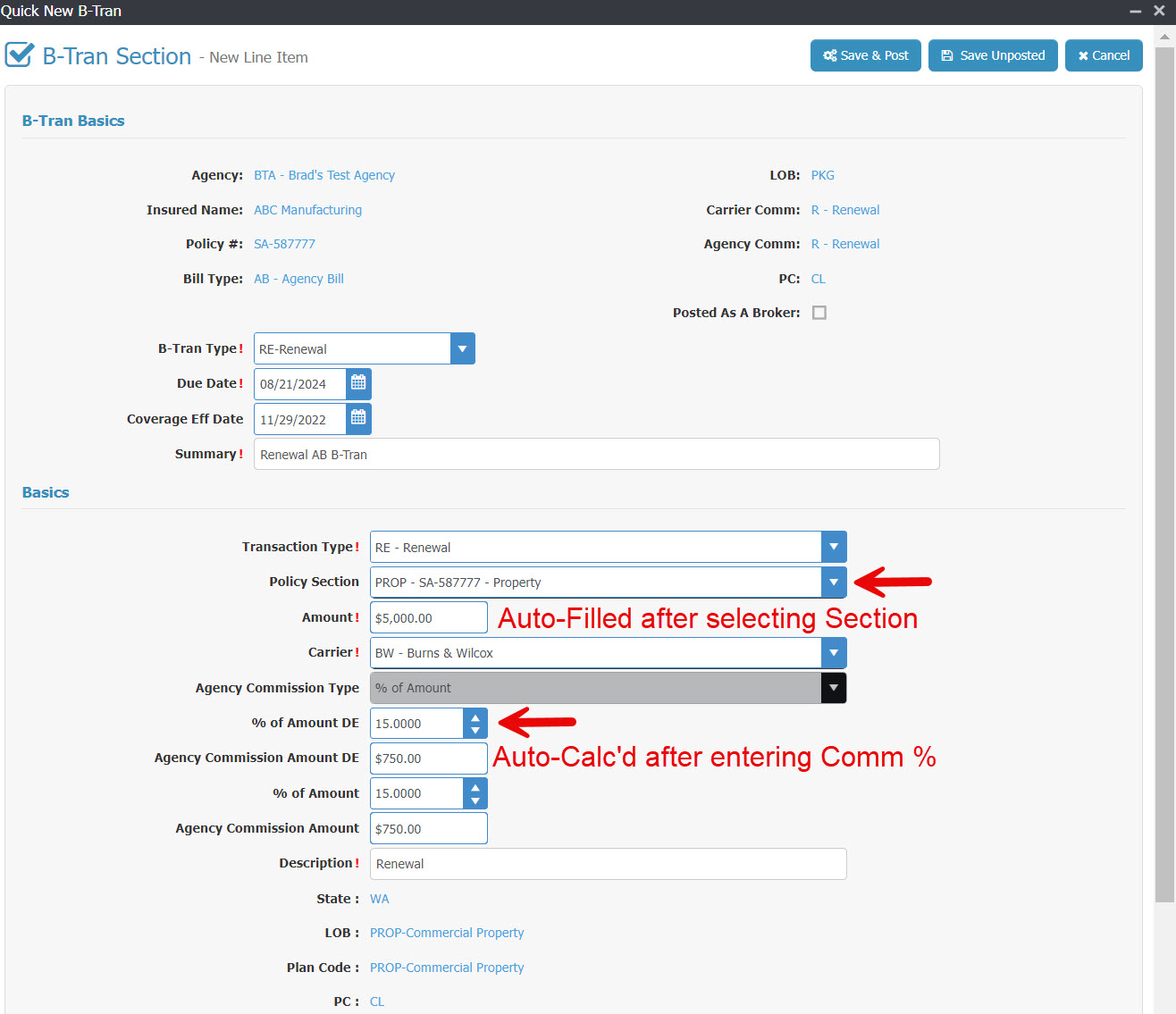
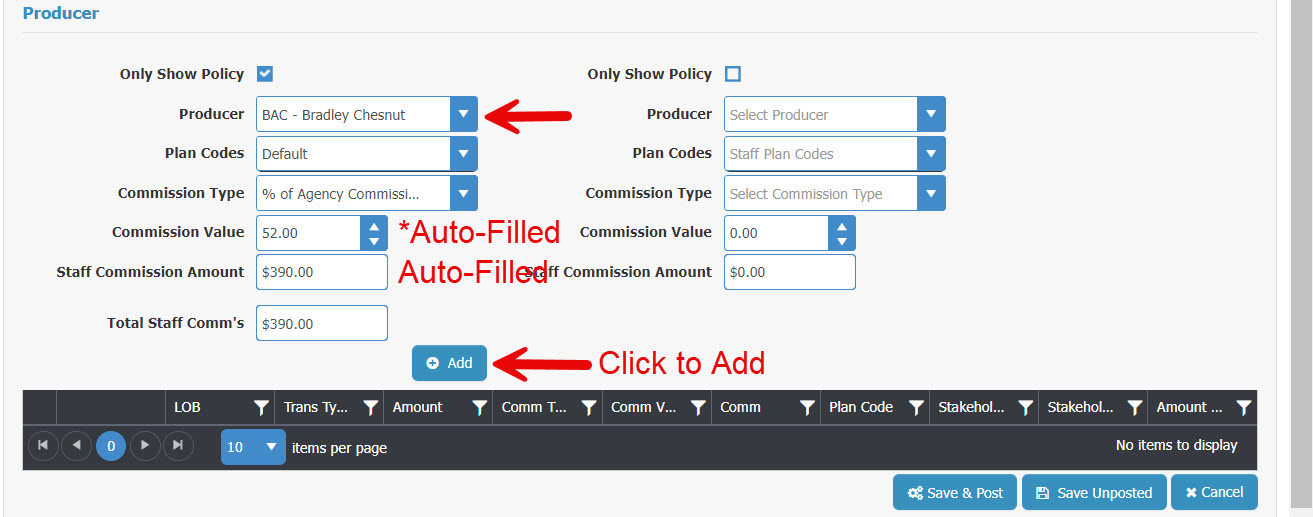
In the images, the fields not pointed out auto-fill. You can see which can be edited.
The fields with an arrow pointing to it you'll either select from a pull-down selection window, edit the field or click the button.
The field where we added, "*Auto-Filled" (with asterisk), it's auto-populated when you select the producer with their default commission % but you can override this field.
You can add multiple producers to this B-Tran.
This B-Tran, if Posted, will now show up on the grid to be included in the reconciliation of the commission statement!
The large agency owners and staff are in pure "awe" of these new features!
We also added Commission Downloading which is another major time saving feature in CP Manager. At this point there are now 3 different ways a B-Tran can be created...
To go with Commission Downloading we also include the Commission Download log & a Commission Download Orphan window.
We now offer 3 ways to handle Premium Financed policies...
Each is handled differently in an accounting system so we created routines to support each.
We added a process to handle Producer Chargebacks where the accounting only affects the producer and not the agency. This is very different than a Cancellation where it subtracts the Premium, does an agency commission chargeback and a producer commission charge back.
This special producer chargeback feature only affects the producers commissions!
The last thing I want to share (I find most people don't read huge lists of enhancement updates) is we continued to add more features to increase your productivity and make doing your job easier. Hundreds of little changes throughout the system will allow you to further increase your productivity.
If there's one thing Mr. Chesnut is absolutely 100% committed to, it's helping agencies to have a highly productive and efficient agency!
Check out CP Manager. Believe me, you'll be really glad you did.
The CSR is the backbone of the agency. When the CSR is highly efficient they have happier clients and the agency flourishes.
This is what your CSR's will have helping them provide the highest level of service for their clients and process their work far faster...
There's a reason agency staff love using CP Manager!
The foundation to CP Manager's design was based upon workflows and productivity strategies. This is why it took over 8 years to develop instead of the typical 1-1.5 years for feature driven systems.
When faced with an economy like we are today, nothing will do more to help you survive it than increasing the productivity of your staff! This is because...
Increased productivity equals increased profitability."
Watch video to learn more...
Click the following video to learn more...
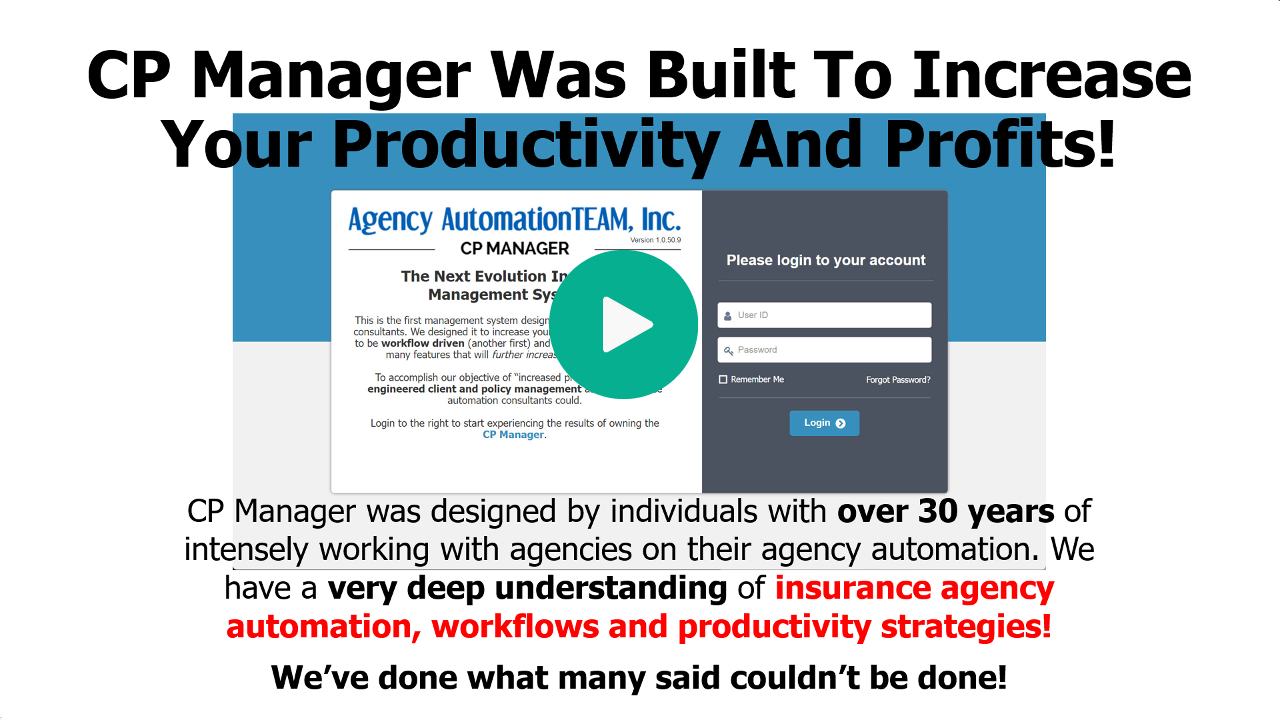
For years and years there's only been one type of agency management system written... the feature driven system.
For the vendors it was always all about the features. It goes something like this... "We need notes, we need follow ups, we need attachments," and the vendor with their team start listing out all of the features they need to add.
Features are the foundation to this system.
A typical design would look like this...
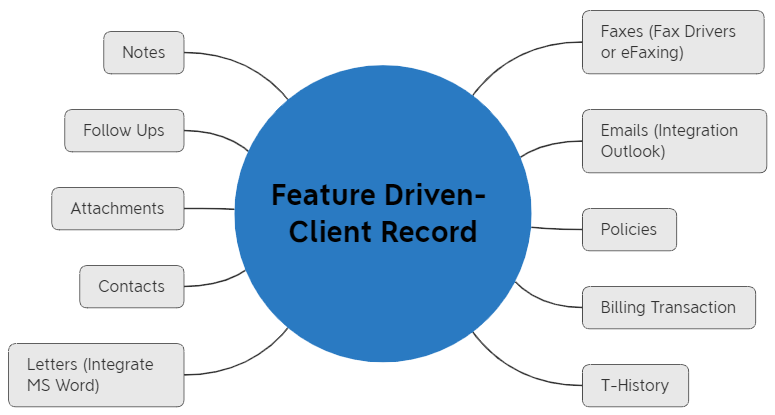
It's listing all of the features and then making sure they're added to the system.
Of course there's some basic integration which needed to be done also.
This is why a feature driven system including accounting can get written and released in 1 to 1 1/2 years. It's just a matter of plugging in the features to the client record.
Almost all also start with just personal line policies. A few have included commercial lines but just the basics to say they offered it. Consistently we hear how weak these systems are in managing commercial lines clients.
Getting a system out onto the market under 2 years is pretty dang impressive. No wonder there's so many systems to choose from now days. At my last count there were 24.
But consistently they have a lot of double entry, are weak in commercial lines and they don't do much to increase the efficiency or productivity in an agency. I know because I've worked on a number of these systems and have talked to agencies on these systems.
My first experience with insurance automation was when I wrote a database program for my agency in the mid 1980's. It was a very simple database which included:
I learned "relational" databases very quickly, and fell in love with the efficiency an automation system offered our agency!
I share more about this part of my history else where. Let's move on.
Since 1989 when I went into consulting working with agencies on their marketing and automation I had one objective and outcome where automation was concerned... to increase the agencies productivity allowing them to do more work in less time to spend more time on marketing and bringing on new clients.
By 1992, helping agencies increase their productivity became my full-time role. Because nothing can do more to help an agency increase its productivity than the right automation I became an expert in agency automation and agency management systems. For 30 years increased productivity has been my focus, and likewise, what I strived hard to master!
As I worked on different management systems it became very obvious management systems were not created equal. Oh sure, they all had client databases, notes, follow-ups, and so forth, but between...
...they were very different. These are the top differences, there are more.
For years I made recommendations to different vendors on how to make their management system more productive. Unfortunately, the most common response I got was, "Our table structures won't support that suggestion."
It became very clear how important the table structures are.
Key point...
When building a productivity driven system the approach is completely different.
Rather than listing all of the features needed you instead map out the workflow steps for handling policy tasks and all of the actions/steps involved in the task.
Take handling an endorsement, for example. You list out the steps to process the endorsement to include the different options. For example, the workflow and process is different if you're downloading with the carrier versus not downloading, or whether you have binding authority or not. These differences need to be addressed.
For each step in the workflow you're listing the feature needed and how it will be used (very important). By understanding how it's used as part of workflow it allows you to re-engineer this feature to create a more fluent and productive solution.
The point is, blue-printing a productivity driven system is based upon how an agency would use the system step by step, policy task by policy task (ie, Renewal, Endorsement, Cancellation, Claim, etc.) and what work agency staff need to stay on top of so things don't slip through their fingers.
A productivity system is all about how an agency would actually use the system, not on what features they need. Features are added to a productivity system based upon their being needed to support a workflow or task.
Nobody understands and knows workflows better than an insurance automation consultant who specializes in teaching workflows to agency staff.
I spent 1 1/2 years blue-printing CP Manager alone. This was 12 hour days 6 days, sometimes 7 days a week. It was a massive job!
You wouldn't believe everything I did to create the blueprints to include using a database program to strategize table structures. This is because I learned very quickly as a consultant the importance of table structures, and I knew that once you started adding clients to the system you had to lock down your table structures.
By the time I was done I had mapped out the flow of data in the system to eliminate almost all double entry creating one of the most single-entry systems on the market, and I had created a system built around how you do your work to create a more efficient, more productive, and a more insurance-specific system. This in part means fewer steps, less windows and less data-entry.
This isn't all. When designing CP Manager it was all based upon workflows and how work is processed creating a more intuitive and common-sense workflow. Considering all of the systems on the market are feature-driven and not workflow or productivity-based, there was no model to follow.
With no examples or models to follow this made the task of blue-printing and having CP Manager written that much more difficult and time-consuming. However, I was blessed to have had over 25 years of agency experience helping agencies to be as productive as they could and having a strong background in both agency automation and in writing database programs.
I could never have achieved what I did with CP Manager if I hadn't had my programming background. It's true, table structures are everything... they're the key to how data flows and how you design the system!
Designing and having the system written based upon workflows and how a person actually uses the system created another challenge... programmers are not taught to write software this way! They're taught to create "feature-driven" systems forcing me to work extremely closely with the programming team and micro-managing them because I was also changing their approach to programming. (By the way, the programming teams all said learning what I taught them on how to write more productive software programs was the #1 thing they appreciated by working with me.)
In the end, to create the results I was after, I ended up:
... and we did a lot of other things with the focus on increased productivity. (Just wait until you see what we did with Notes, Follow Ups, Attachments, Correspondence, etc... it's mind-blowing!)
There were a lot of examples of how to add these features to the system, but none of these features in other systems were designed for a productivity driven system. This is why I ended up re-engineering all of these features... to support the productivity driven system.
Agencies call CP Manager the "most insurance specific systems they've ever experienced".
It took over 8 years to write CP Manager, plus the 1 1/2 years of blue-printing. Using it and seeing how intuitive and fluent it is, experiencing how single-entry it is and how everything flows so smoothly, and seeing everything you can do with minimal keystrokes, I smile from ear to ear.
It's feature rich, that's for sure, but more importantly it's extremely productive. We clearly achieved what I was after when designing and having CP Manager written.
I'm very proud of CP Manager. More importantly, our clients are loving CP Manager!
CP Manager is advancing the agency management system from being feature driven to finally being productivity and workflow driven. This advancement is long overdue!
The creation of CP Manager is the biggest re-engineering and overhaul of the agency management since they went from accounting based to client/policy driven in the 1980's.
What's frustrating about this is the insurance industry has always been workflow-driven, and we've had client-based agency automation since the early 80's, but building a system based upon workflows took 40 years with CP Manager being the first.
Since the last big change in management systems in the 1980's the only other big changes have been going from DOS to windows (this didn't change their design, it only changed the operating environment), then from windows to browser based (again, this didn't change their design, it only changed the operating environment).
I believe you will be very impressed when you have a walk-through of it.
If you want to learn more about the process to get CP Manager written, and want to learn more about the design of management systems you can request an informational piece I wrote called, "Agency Management Systems Are Not Created Equal". In case you're curious, I also address why no other vendor has been able to create a productivity driven system.
Schedule a Walk-Through now and experience CP Manager yourself.

Although you may have heard of an insurance automation system, you might not understand the difference between Insurance Automation Systems and CRM. One of the main things to note is that an insurance automation system is essentially a CRM plus added features. CRMs are generic systems. They have many capabilities, but they also can be quite expensive and need to be updated often. Insurance automation systems are better in three main ways: they are specific, total, and productive.
There are many benefits to using technology, such as workflow automation, efficient commissions processing, and high-quality customer service. Despite this, if your agency is not organized, these systems will not fall into place.
If you are looking to select an agency management system then there are two types of systems to look out for:
As it would be pretty obvious, policy-based systems have a core organization that is centered around policies. Contact-based means it is centered around contacts.
These types of systems track information based on individual contact. This means that all of the systems track information that is provided from a contact. All of these aspects can include policies, agents, commissions, groups, carriers, and relationships to the contact.
These systems begin with an individual client. This person may have one or more policies with you. You will be able to see each of these policies and how they are connected to that client. It does not matter if the policies are from different providers, they will still be connected to that client.
As the name hints, a policy-based system centers everything around the policy. Each policy will be tied to the client, the carrier, and the agent who connected the three. The commission will also be connected. Rather than seeing one person connected to all of their policies, you will see individual policies and individuals as multiple records. If you use a spreadsheet system, this is most likely a policy-based solution.
The major benefit of insurance automation systems is that they are built for your industry. It can also cut down implementation time. This means you can cut down your time focusing on remedial tasks, and focus more on your clientele.
There are many more aspects to an insurance automation system than simply helping with tracking communications. These systems can help with tracking agents, tracking policies, managing commissions, and managing email marketing campaigns. They can also help with task management, business performance analysis, and insurance specific reporting. This is why insurance automation systems are a total system.
Instead of working harder, you can be more productive by using an insurance automation system. By using these systems, you will boost your productivity, your efficiency, and automate all of your workflows.
Many tasks can be automated such as:
Overall, insurance automation systems work by helping you do your job better. Rather than spending countless hours on slow tasks, you can use your system to automate workflows, and stay organized better than you ever could with a CRM.

Although marketing and generating leads through YouTube may not be as clear cut as through other forms of social media, YouTube is known for connecting with clients through informative and dynamic videos. Using this platform may increase your full sales potential if done right, helping you to generate more leads for your business. With its variety of user-friendly features and ways to optimize content, you truly can’t go wrong with lead generation via YouTube. Find out how you can increase lead engagement through Agency AutomationTEAM YouTube.
Optimizing content goes a long way in gaining and retaining leads via YouTube. There are three main ways to pursue true content optimization: educating, answering, and CTA.
You can also optimize your content by including popular industry-related hashtags and keywords into your content. This will help your videos stand out in searches and drive viewership, eventually increasing the number of leads you’ll have over time. With YouTube’s search and video display algorithms, content optimization is your best tool for lead generation.
A call to action is an important part of content optimization, so it’s imperative you create something that will engage viewers. An easy way to implement this is with YouTube’s interactive card feature. These cards usually appear at the end of YouTube videos and will allow you to link other sites, resources, and content. Include related sites like your website landing page or direct them on how to contact you or get a quote. Using these popular interactive cards as a CTA will guide viewers to your business, creating leads you can count on in the process.
Also related to YouTube optimization, interacting with viewers by answering their questions and comments will let them know you are a trustworthy source of information. Consistent engagement with viewers is shown to increase lead activity, as well. Showing your viewers genuine care shows an initiative for their well-being and customer care within your business model.
If your agency doesn’t have time for aggressive marketing efforts via YouTube, don’t worry. Agency AutomationTEAM YouTube provides informative videos that will easily help you take your marketing management system to the next level. Designed with the agency in mind, CP Manager is the perfect solution for saving time on marketing strategies with a system designed for cross-selling, x-dating, and generating marketing reports. After using this system, you’ll be well on your way to creating and following up with leads via YouTube.

Twitter is a great way to connect with your audience and generate leads. Having an Agency AutomationTEAM Twitter is helpful in providing consistent educational content to Twitter users. This also helps facilitate trust, solidify contacts, and convert Twitter users into leads for your business. Find out how to pursue a confident lead-nurturing process through Twitter to contribute to your bottom line.
A high click-through rate is an important factor when using Twitter for business purposes. Click-through rate shows the amount of times that users interact with your posts. Increasing this rate allows businesses to convert this type of media traffic into leads.
To increase your click-through rate and optimize on-page conversion, try the following:
Using these methods will grab the attention of your followers, encouraging them to interact with your content. Increased Twitter engagement is shown to boost click-through rate, resulting in more lead conversions for your business.
Once you’ve successfully gained a few Twitter leads, you’ll need to maintain your engagement with them in order to see results.
Following your leads on Twitter is a great way to start this process. You can also become an active follower of theirs by interacting with their posts with consistent likes, retweets, or comments. This keeps you on the leads’ radar, all while cultivating a relationship with them. Be sure to keep it light and avoid shop talk, however. Building a good rapport with followers and leads shows an increase of engagement over time – both on and off Twitter.
Most lead engagement strategies like these are free, but they do involve time and attention. With a little extra interaction online, however, you’re sure to increase the number of leads you maintain and build a positive relationship with them. Building this kind of trust and rapport with online leads will boost sales in time.
Highly productive agencies often don’t have time for aggressive marketing efforts. This is a simple fix with Agency AutomationTEAM’s Twitter solution. Here, you can find tips and other educational content to effectively use your agency software for keeping track of marketing leads and engagement.
In addition to helpful Twitter lead engagement information, Agency Automation TEAM’s CP Manager takes effective marketing strategies to the next level. A big advantage to this management system is its ability to handle new leads and clients, all while saving you time and resources in the process. Use this comprehensive system for cross-selling product lines, x-dating strategies, or creating marketing reports based on client records.
Improve your retention rates by increasing renewal management and marketing to the right clients at the right time. All lead information can be easily saved across the whole system, making it easy to contact your leads when you need to. Additionally, your generated lead lists will include the best date and time to reach out.

It is the 21st century and as such you need to rethink the way you’ve been doing agency work to best reflect the abilities you have in the digital age. Using old or outdated systems or still working off business practices from 10 years ago or more is not going to be enough anymore. You need an agency management system that understands the demands and abilities of work and life in the year 2020 and beyond. You also need a digital presence that can elevate the work you’re doing and keep your agency as productive as possible.
CP Manager is the solution. Not only have we painstakingly designed a system that was handcrafted for the work your agency does on a daily basis, but we have savvy other systems and other companies. We utilize all possible digital channels and social media to get you the best possible product and to reach you in the best possible way.
Insurance and the way we handle it has changed a lot since the first insurance agency started. The way we package policies, determine risk, onboarding clients into systems all has changed and all requires very prudent digital progress. We maximize this through use of social media to stay in constant contact with our customers and ensure you get the best service.
Facebook and other social media are not just a place to post pictures and share events. They’re a way to stay in contact and in the know about your industry and about the needs of customers and clients. It’s a communication tool for us and a sign that we know what we’re talking about when we talk about the need for forward thinking, digital oriented solutions to problems.
This 100% paperless system was designed with your agency and your needs in mind. Not only does it integrate with email systems to offer extensive email correspondence, e Signatures, and other electronic forms of communication, we internact all internal messaging as well to make your office as eco friendly and paperless as you could want. This is among the easiest systems to learn and use (we have our extensive beta testing to thank for that), the most powerful for multi-agent organizations, and among the most impactful when it comes to productivity in the workplace.
Visit our AutomationTEAM Facebook page to understand why we are among the best of the best when it comes to making sure you have a digital, progressive, hi-tech management system for your agency. Get everything you can out of your system along with 24/7 support and the best and easiest software you can imagine for your agency.
Submit for more information and book a demo for our product as well. You won’t regret it and you’ll have your mind blown by the effectiveness of our software.

When you run a small business, a lot of the organizational tools, applications, software systems, or advice doesn’t entirely apply to you. Especially in the insurance business, where you deal with lots of sensitive and confidential information on a daily basis, you can’t rely on just any sort of management system to keep things running smoothly. You need something you can trust, and something that can be well integrated in your existing interface and operational function.
As a small insurance agency, you put a lot of heart into your clients and their needs and each policy you represent. A lot of times, it’s usually up to one or two people to manage the organizational process of a small insurance agency, and the techniques and tactics used here can vary.
Is there an easy way to integrate a flawless system for management for a small insurance business? We think there absolutely is! In fact, that is what our product is all about — making access to software designed for management simple for small-scale businesses.
Small Insurance Agency Management Systems sound almost too good to be true, right? Or maybe you need more convincing. Here are three ways our system has absolutely revolutionized many small agencies in the insurance industry!
When you’re dealing with a smaller agency, you can’t spend lots of money or time training your staff on a new system that is complex and layered, with many features hidden in menus and pop-ups that aren’t easily accessed. You need something that will be helpful from the start and quick to master, which is exactly how our management system works. It was designed with small insurance agencies in mind, so it caters to this industry.
Without a management system, a lot of the busy work done in insurance agencies is a manual task. Luckily, we can change that for you. Our CP Manager can help you get more contracts, organize carriers, and process policy tasks automatically for you. The automated task buttons included in the efficient toolbar makes every policy task done easily with a click, and the organization feats are beyond what could be done from a manual filing system.
For many small businesses, accounting is a major bottleneck to everyday operations and can be one of the most expensive sections of your business. The irony, right? With our CP Manager, you can cut back on accounting costs and focus on the numbers without the fuss. Agency accounting is a big area, and important to your success, so diving in is a bit troubling. Many of the tough accounting process tasks are now done with a single button; for invoice, emails, receipts, commissions, and more!
Like what you see? Great, let’s get things going! Come learn more about AAT and get yourself ready to go with our CP Manager system for small insurance agencies.